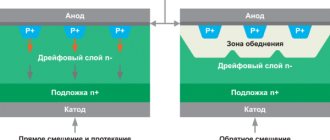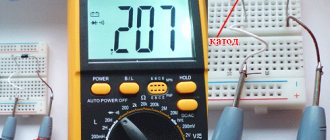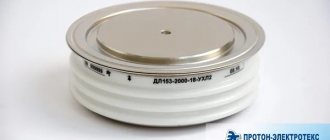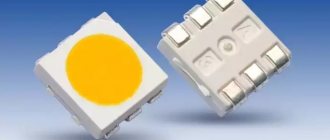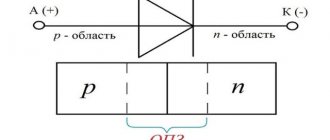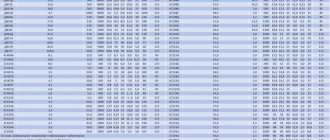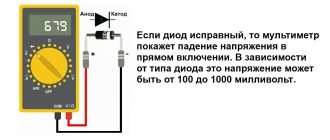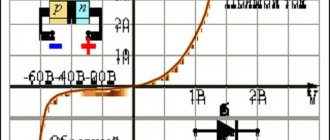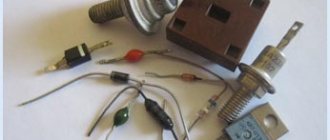Schottky diode components are a type of semiconductor devices that do not use the pn junction principle. The area of contact between the metal surface and the semiconductor material acts as a one-way conductor. Below we consider the characteristics of one of the popular 1n5819 models, its application, and lists Russian-made products that can replace this diode.
Case DO-41
general information
These parts received their name in honor of the German scientist W. Schottky, who is credited with determining the properties of the barrier region at the point of contact of the semiconducting element with the metal. Gallium arsenide often plays the role of the first in diode products. Sometimes a silicon semiconductor is used. Metal parts can be platinum or silver; gold options are less common.
Surface Mount Option
In terms of their parameters, these products differ in many ways from silicon diodes using p - n junction:
- They have a small junction capacitance. This makes it possible to operate at high frequencies and allows these components to be used to create digital circuits.
- When a Schottky product is connected directly, the voltage drops by an amount 2-3 times less than when a standard product designed for rectification is turned on. Because of this phenomenon, they are more productive in a direct current situation, since the lower drop value implies that the heat loss dissipated into the environment will be significantly lower. But, if the reverse voltage indicator increases significantly, surpassing the value of a hundred volts, the magnitude of the drop also increases and becomes slightly different from the situation when using a traditional diode. This effect determines the limits of the optimal operating voltage for this type of diode elements: it is better to choose them when the voltage is in the tens of volts.
- These diodes are also characterized by fast recovery, so they can be used in configurations that rectify voltages up to 100 kilohertz and above. Due to the absence of the diffusion process of third-party electric charge carriers, these diode components are characterized by increased performance.
Important! In a situation where the average current is equal to one unit of measurement (1 A), and the reverse voltage parameter does not exceed 40 V, the in5819 model is often installed. It is available in two versions. The SMD version for surface installation has a plastic housing and is marked SS14. The cylindrical version with long “antennae” leads intended for threading into prepared holes on the board also has a plastic body.
Traditional design of this diode
Flaws
Simatic step 7 professional/basic v15 for totally integrated automation portal
The main disadvantage of the 1N5822 diode is its low reverse voltage of 40 volts. This problem is common to all Schottky barriers and is explained by the peculiarity of their structure. A conventional diode, after breakdown by increased reverse voltage, in some cases is able to return to normal operation. With Schottky diodes, such as 1N5822, such a miracle will no longer happen, and the part will completely fail. This reverse voltage characteristic condemns these electronic components to operate only in low-voltage circuits. This means that their versatility and the number of devices in which they can be found are significantly reduced.
The second disadvantage of the 1N5822 is its high reverse leakage current. We are talking about connecting a part in which a greater potential is applied to the cathode than to the anode. Ideally, a pn junction should not conduct current in this direction. In fact, some of the charges still flow in the opposite direction. Therefore, this current is called leakage, i.e. something unwanted and wrong.
This problem is again characteristic of all Schottky barriers, and not just 1N5822. For this particular diode, the leakage current strongly depends on temperature and can reach 0.2 amperes. In this case, the problem has an avalanche-like character, i.e., if reverse current begins to flow through the diode, it heats up. An increase in temperature, in turn, leads to an increase in leakage. This increases the heating even more. So in a vicious circle until the part finally overheats and its thermal breakdown occurs, which is irreversible. Therefore, if the 1N5822 will be used in conditions close to overload, care should be taken to remove excess heat.
1N5822 is a diode whose characteristics allow it to be used in the output circuits of modern power supplies. It is becoming more and more in demand every day. This is explained by the ability to operate at high currents for such a housing, up to 3 amperes, and at fairly high frequencies.
Characteristics of Schottky diode 1N5819
Diode SS14: characteristics
Both types of design in5819 have the same operating plan characteristics. It's worth noting here:
- average current value after rectification – 1 Ampere;
- the total capacity of the housing and the crystal element is 110 picofarads;
- the highest reverse operating voltage is 40 volts (the same figure for the peak value);
- AC reverse voltage value – 28 volts;
- operating temperature ranges from -65 to +125 degrees Celsius; thus, barrier elements can operate in a wide range of temperatures, including extremes.
Important! The identity or proximity of the peak and operating voltage values is a characteristic feature of Schottky elements.
Diode pinout 1N5819
Characteristics of in5822 Schottky diodes
For a diode to work correctly, it must be correctly connected to the circuit being prepared. To do this, the master needs to correctly determine the cathode and anode poles of the product. The cathode marking on the version of the model under consideration, equipped with long leads, has the form of a light stripe applied along the perimeter of the cylindrical body from the corresponding end. It is often applied with silver paint. The anode is not specially marked in any way. The SMD version is also supplied with stripes.
For the diode component to function properly, the negative terminal, marked with a stripe, must be connected to the negative terminal of the current source (or voltage, depending on which circuit the diode is used in). The anode, in turn, is connected to a positively charged pole.
Diode element pinout
Features of application
When considering the characteristics of the 1n5819 diode, you need to pay attention to its operational features and the limitations imposed by the design. The model is often used as a rod for shunting the terminals of low-power transistor devices. In those electrical circuits where there is a risk of increasing the reverse voltage value compared to that noted in the technical description, it is not worth installing such barrier diodes. When installed in such a circuit, they soon become unsuitable for further use. Options 1n5818 and 1n5817 are even more demanding on reverse voltage: the first model can only be installed in conditions where the parameter does not exceed 30 volts, and for the second it should be no higher than 20 volts.
Parts of the 1 n 5817-1 n 5819 diode series are used in the following areas:
- battery chargers;
- switching power supplies of different types;
- for receiving alpha, - and beta radiation;
- for shunting transistor devices;
- in high frequency rectifying devices;
- in the production of solar batteries;
- in neutron beam recognizers.
Important! Although these parts have a significant operating temperature range and can withstand temperatures up to 125 degrees Celsius, during installation you need to take care to remove excess heat from the plastic body of the element. A very high temperature can cause an uncontrolled increase in the reverse current, which is very dangerous, since it entails the disintegration of the junction or its breakdown.
Polarity of 1N5817 diodes
Very important points for the installation of any PCB components are the correct determination and observance of polarity. With the diode model under review, everything is simple in this regard - the side of the case where the cathode output is located is equipped with a strip of a different color (often light) that wraps around the case. The anode terminal is not specially marked in any way. On the rest of the body, laconic markings are applied with the same coloring composition used to make the strip.
Mounting the 1N5817 diode on the board
The components of the 1n5817-1n5819 diode series are installed by soldering using TNT technology. In this case, the pins are installed in specially prepared holes on the board. The body itself can be placed either parallel to the surface or perpendicular. As for the maximum temperature value, it should not exceed +250 degrees Celsius, its exposure time is allowed no more than 10 seconds. Low and high ambient temperatures also have restrictions: no less than -65 and no more than +150 degrees, respectively.
Closed Schottky diode
The diode element is considered closed in a situation where it blocks the passage of current. In some cases, such a diode installation is practiced purposefully. You can reliably assess how well an element conducts electric current by using a measuring device (ammeter or multimeter) and finding out the amount of current passing.
Open and closed diodes
Open Schottky diode
In the diagrams, diode elements are designated as arrows, demonstrating the direction of current flow in a situation where the diode is open. Under normal conditions, this situation is created by connecting the anode to the positive pole of the current (or voltage) source, and the cathode to the negative pole. In addition, it is imperative that the voltage exceeds the threshold at which the element begins to open (about 0.5 V). You can check the passage by measuring the current with a measuring device. An indirect indicator can be voltage - the measurement results must exceed the threshold and correspond to a direct connection.
Schottky diode device 1N5817
The cylindrical housings used for the production of diodes belong to the DO-41 type. They are made of molded plastic; tinned rod output elements with polarization are placed on the sides (bottom) of the cylinder. These rods are made from wire. In terms of flammability, diode bodies pass UL 94 category with specification V-0. This means that combustion ends after 10 seconds.
Dimensions and pinout of the 1N5822 diode
How to make a battery
Each type of radio component housing has its own specific dimensions. The number of pins and their purpose also differ. These things are taken into account at the design stage of a printed circuit board, when it represents only a computer model. Therefore, without knowing the dimensions and purpose of the pins of an electronic component, it cannot be used to create a new device.
The anode and cathode of the 1N5822 diode are located on the sides of the part. To determine which pin is which, there is a special marking on the case in the form of a strip. It is applied from the cathode side. The leads are made of copper wire with a diameter of 1.22 to 1.32 mm. For programs that do not favor the metric measurement system, you will have to take into account dimensions in inches. In this case, the thickness of the leads is from 0.048 to 0.052 inch. Such dimensions were not taken out of thin air, because the terminals of the part must confidently and without heating withstand the currents passing through them.
Strip on 1N5822
Note! Most imported and domestic diodes have a strip on the cathode side. Some Soviet parts are marked the other way around, i.e.
strip on the anode side. Incorrect activation can lead to failure of both the diode itself and some (sometimes very rare and expensive!) parts on the board in which it is installed.
The length of the legs of the radio component is also standardized. For 1N5822 it is exactly 25.4 mm or 1 inch. Manufacturers do not skimp on copper for making leads, so their length is always made with a margin. After installing the part on the printed circuit board, excess fragments of the legs are bitten off using wire cutters. In some cases, the diode leads are not shortened and are left for additional cooling. Manufacturers of high-quality electronics do not accept such methods, because a heavy part mounted on long legs will break them off over time.
The dimensions of the case are no less important. The 1N5822 diode in the DO-201AD package has a length from 7.2 to 9.5 mm. Accordingly, 0.285 – 0.375 inch. In this case, the diameter ranges from 4.8 to 5.3 mm (0.19 – 0.21 inch). Compared to other diodes, the sizes are quite large. They are directly related to the current passing through the part and the thermal power that the housing must dissipate. The more massive it is, and the larger the area of its contact with air, the more successfully the part gets rid of excess heat.
Dimensions 1N5822
Analogue 1N5819
Often when working with boards, the question arises of how to choose a domestic analogue for the 1n5819 component. There are no full-fledged substitutes on the market, but Russian manufacturers produce a number of products that can be used as an analogue. These are models KD268-KD273, as well as KD238.
We must remember! They are available in a slightly different housing design - T0-220. In Belarus, they produce the KDSh2105V diode, which has operational characteristics identical to 1n5819.
The diode in question is characterized by high performance and lowers the voltage less than standard products, which makes its use beneficial in a number of situations. When installing the product, you must determine the correct polarity.
Analogs 1N4007
Of course, such a popular diode could not be ignored by global manufacturers of semiconductor devices and released their complete analogues:
- Motorola - HEPR0056RT;
- Philips - BYW43;
- Diotec Semiconductor - 10D4, 1N2070, 1N3549;
- Thomson - BY156, BYW27-1000;
- domestic analogue - KD258D.
Rectifier diodes 1N4001 – 1N4007 Diodes 1N4001, 1N4002, 1N4003, 1N4004, 1N4005, 1N4006, 1N4007 have high throughput and low forward voltage drop. In terms of applicability, diodes 1N4001 - 1N4007 are general purpose diodes that rectify currents in circuits up to 1A with a voltage of 50V - 1000V. Diodes of these series have the ability to accumulate charge up to 20pF and can be temporarily used as varicaps. Diode housing type – DO-41. The body material is non-flammable polymer. Operating frequency – up to 60Hz.
Material on the topic: What is a time relay
The cathode terminal of the diode is indicated by a stripe. The diode outputs are axial, the type of installation is through holes, for soldering. The most common use of diodes is in power supplies for various household appliances. The characteristics of the diodes are shown in the table below. The operation guarantee of the diodes 1N4001 – 1N4007 supplied by our company is 2 years. This is supported by the necessary quality documents. The final price for diodes 1N4001, 1N4002, 1N4003, 1N4004, 1N4005, 1N4006, 1N4007 depends on the quantity, delivery time, manufacturer, country of origin and form of payment.
Diodes 1n4007.
Video
Coffee capsule Nescafe Dolce Gusto Cappuccino, 3 packs of 16 capsules
1305 ₽ More details
Coffee capsules Nescafe Dolce Gusto Cappuccino, 8 servings (16 capsules)
435 ₽ More details
Toners for Brother printers

